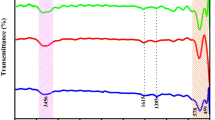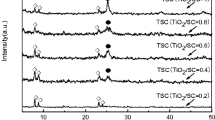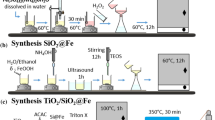Abstract
Magnetic core–shell TiO2@CoFe3O4 (TCM) composite photocatalytic particles with a core–shell structure were synthesized by the co-precipitation method as a novel catalyst for methylene blue (MB) dye degradation and adsorption efficiency of heavy-metal ion Pb(II) from aqueous solution. Various analytical techniques have verified the formation of the TCM core–shell through TEM, XRD, FT-IR, Raman, PL, and UV analysis. The presence of TiO2 and cobalt magnetite in the TCM core shell is confirmed by XRD analysis. The formation of a homogenous CoFe3O4shell on TiO2 spheres is confirmed by HR-TEM investigation. TiO2 nanoparticle has a rutile structure with an average crystallite size of about 57.44 and a TCM core–shell of about 64.62 nm. From UV and PL studies, it was found that the core shell absorbs the visible range of the electromagnetic spectrum, which improves the effective separation between photo carriers. This study focused on several factors that influence metal ion adsorption, including initial concentrations, adsorbent dose, pH, and contact time. The TCM nanocomposite successfully separated the heavy metal ion Pb(II) from aqueous solutions, and the model predictions exactly matched the experimental results. For TCM material, the maximum adsorption efficiency for Pb(II) was 33.09 mg/g. The photocatalytic performance of TiO2 and TCM is about 12% and 91% after 60 min for MB dye degradation. It was found that TiO2@CoFe3O4 core–shell nanoparticles perform better as photo catalysts than pure TiO2 and CoFe3O4due to their high efficiency and reusability. Furthermore, the analysis revealed that heavy metal adsorption from aqueous solutions could be reused over seven cycles with no adsorption capacity modification.





















Similar content being viewed by others
References
Khorramfar S, et al. equilibrium and kinetic studies of the cationic dye removal capability of a novel biosorbent Tamarindus indica from textile wastewater. Color Technol. 2010;126(5):261–8.
Shafiee M, et al. application of oak powder/Fe3O4 magnetic composite in toxic metals removal from aqueous solutions. Adv Powder Technol. 2019;30(3):544–54.
Liu Y, et al. Enhanced adsorption removal of methyl orange from aqueous solution by nanostructured proton-containing δ-MnO 2. J Mater Chem A. 2015;3(10):5674–82.
Guendouz S, et al. Biosorption of synthetic dyes (Direct Red 89 and Reactive Green 12) as an ecological refining step in textile effluent treatment. Environ Sci Pollut Res. 2013;20(6):3822–9.
Ahmed M, El-Katori EE, Gharni ZH. Photocatalytic degradation of methylene blue dye using Fe2O3/TiO2 nanoparticles prepared by sol–gel method. J Alloy Compd. 2013;553:19–29.
Saha S, Wang J, Pal A. Nano silver impregnation on commercial TiO2 and a comparative photocatalytic account to degrade malachite green. Sep Purif Technol. 2012;89:147–59.
Marien CB, et al. TiO2 nanotube arrays: influence of tube length on the photocatalytic degradation of paraquat. Appl Catal B. 2016;194:1–6.
Bai X, et al. Uniformly distributed anatase TiO2 nanoparticles on graphene: Synthesis, characterization, and photocatalytic application. J Alloy Compd. 2014;599:10–8.
Xiang Q, Lv K, Yu J. Pivotal role of fluorine in enhanced photocatalytic activity of anatase TiO2 nanosheets with dominant (0 0 1) facets for the photocatalytic degradation of acetone in air. Appl Catal B. 2010;96(3–4):557–64.
Leung T, et al. Photocatalytic disinfection of marine bacteria using fluorescent light. Water Res. 2008;42(19):4827–37.
Chen X, Mao SS. Titanium dioxide nanomaterials: synthesis, properties, modifications, and applications. Chem Rev. 2007;107(7):2891–959.
Fujishima A, Zhang X, Tryk DA. TiO2 photocatalysis and related surface phenomena. Surf Sci Rep. 2008;63(12):515–82.
WF Z, MS Z. Raman scattering study on anatase TiO2 nanocrystals. 2000.
Wanrong Z, Wei S, Pinghui Y. Preparation and Functional Application of Janus Particles. Prog Chem. 2018;30(11):1601.
Beydoun D, et al. Occurrence and prevention of photodissolution at the phase junction of magnetite and titanium dioxide. J Mol Catal A: Chem. 2002;180(1–2):193–200.
Yeganeh M, et al. The magnetic characterization of Fe doped TiO2 semiconducting oxide nanoparticles synthesized by sol–gel method. Physica B. 2017;511:89–98.
Ai L, et al. Activated carbon/CoFe2O4 composites: facile synthesis, magnetic performance and their potential application for the removal of malachite green from water. Chem Eng J. 2010;156(2):243–9.
Zhang D, et al. Magnetic nanoparticle-mediated isolation of functional bacteria in a complex microbial community. ISME J. 2015;9(3):603–14.
Mohanta O, et al. Degradation of Congo red pollutants using microwave derived SrFe12O19: an efficient magnetic photocatalyst under visible light. J Alloy Compd. 2013;564:78–83.
Ma P, et al. Synthesis and photocatalytic property of Fe3O4@ TiO2 core/shell nanoparticles supported by reduced graphene oxide sheets. J Alloy Compd. 2013;578:501–6.
Pauline S, Amaliya AP. Synthesis and characterization of highly monodispersive CoFe2O4 magnetic nanoparticles by hydrothermal chemical route. Arch Appl Sci Res. 2011;3(5):213–23.
Habibi N, Rouhi P, Ramavandi B. Synthesis of adsorbent from Tamarix hispida and modified by lanthanum metal for fluoride ions removal from wastewater: Adsorbent characteristics and real wastewater treatment data. Data Brief. 2017;13:749–54.
Delshab S, Kouhgardi E, Ramavandi B. Data of heavy metals biosorption onto Sargassum oligocystum collected from the northern coast of Persian Gulf. Data Brief. 2016;8:235–41.
Peng S, Xie J, Sun S. Synthesis of Co/MFe2O4 (M= Fe, Mn) core/shell nanocomposite particles. J Solid State Chem. 2008;181(7):1560–4.
Gallo J, et al. Water-soluble magnetic glyconanoparticles based on metal-doped ferrites coated with gold: Synthesis and characterization. J Mater Chem. 2010;20(44):10010–20.
El-Toni AM, et al. Design, synthesis and applications of core–shell, hollow core, and nanorattle multifunctional nanostructures. Nanoscale. 2016;8(5):2510–31.
Gawande MB, et al. Core–shell nanoparticles: synthesis and applications in catalysis and electrocatalysis. Chem Soc Rev. 2015;44(21):7540–90.
Qu J, et al. Eye-Readable Detection and Oxidation of CO with a Platinum-Based Catalyst and a Binuclear Rhodium Complex. Angew Chem. 2019;131(35):12386–91.
Frost R, et al. Core-Shell Nanoplasmonic Sensing for Characterization of Biocorona Formation and Nanoparticle Surface Interactions. ACS Sensors. 2016;1(6):798–806.
Dobson J. Magnetic nanoparticles for drug delivery. Drug Dev Res. 2006;67(1):55–60.
Kumar CS, Mohammad F. Magnetic nanomaterials for hyperthermia-based therapy and controlled drug delivery. Adv Drug Deliv Rev. 2011;63(9):789–808.
Wei S, et al. Multifunctional composite core–shell nanoparticles. Nanoscale. 2011;3(11):4474–502.
Clime L, et al. Magnetic nanocarriers: from material design to magnetic manipulation. Int J Nanotechnol. 2008;5(9–12):1268–305.
Tanaka S, et al. synthesis of highly-monodisperse spherical titania particles with diameters in the submicron range. J Colloid Interface Sci. 2009;334(2):188–94.
Dou W, Liu J, Li M. Competitive adsorption of Cu2+ in Cu2+, Co2+ and Ni2+ mixed multi–metal solution onto graphene oxide (GO)–based hybrid membranes. J Mol Liq. 2021;322:114516.
Es-sahbany H, et al. Adsorption of heavy metal (Cadmium) in synthetic wastewater by the natural clay as a potential adsorbent (Tangier-Tetouan-Al Hoceima – Morocco region). Mater Today: Proc. 2021.
Wajid Shah M, et al. Facile synthesis of defective TiO2−x nanocrystals with high surface area and tailoring bandgap for visible-light photocatalysis. Sci Rep. 2015;5(1):15804.
El-Sherbiny S, et al. synthesis, characterization and application of TiO 2 nanopowders as special paper coating pigment. Appl Nanosci. 2014;4(3):305–13.
Jiang J, Ai L. Synthesis and characterization of Fe–Co binary ferrospinel nanospheres via one-step nonaqueous solution pathway. Mater Lett. 2010;64(8):945–7.
Foroutan R, et al. influence of chitosan and magnetic iron nanoparticles on chromium adsorption behavior of natural clay: Adaptive neuro-fuzzy inference modeling. Int J Biol Macromol. 2020;151:355–65.
Foroutan R, et al. Efficient arsenic(V) removal from contaminated water using natural clay and clay composite adsorbents. Environ Sci Pollut Res. 2019;26(29):29748–62.
Mead D, Wilkinson G. The temperature dependence of the raman effect in some wurtzite type crystals. J Raman Spectrosc. 1977;6(3):123–9.
Esvandi Z, et al. Uptake of anionic and cationic dyes from water using natural clay and clay/starch/MnFe2O4 magnetic nanocomposite. Surf Interfaces. 2020;21:100754.
Zhang J, et al. UV Raman spectroscopic study on TiO2. I. Phase transformation at the surface and in the bulk. J Phys Chem B. 2006;110(2):927–35.
Tamilselvan V, et al. Growth of rutile TiO2 nanorods on TiO2 seed layer deposited by electron beam evaporation. Appl Surf Sci. 2012;258(10):4283–7.
Itin V, et al. Synthesis of cubic ferrite CoFe2O4 by spray pyrolysis. 2018.
Liu Z, et al. effect of embedded-silica on microstructure and photocatalytic activity of titania prepared by ultrasound-assisted hydrolysis. Appl Catal B. 2004;52(1):33–40.
Musić S, et al. Chemical and micro structural properties of TiO2 synthesized by sol-gel procedure. Mater Sci Eng, B. 1997;47(1):33–40.
Han H, et al. α-Fe 2 O 3/TiO 2 3D hierarchical nanostructures for enhanced photoelectrochemical water splitting. Nanoscale. 2017;9(1):134–42.
Suharyadi E, et al. Photocatalytic activity of magnetic core-shell CoFe2O4@ ZnO nanoparticles for purification of methylene blue. Mater Res Express. 2020;7(8):085013.
Kalam A, et al. Modified solvothermal synthesis of cobalt ferrite (CoFe2O4) magnetic nanoparticles photocatalysts for degradation of methylene blue with H2O2/visible light. Results Phys. 2018;8:1046–53.
Marsooli MA, et al. preparation and characterization of magnetic Fe3O4/CdWO4 and Fe3O4/CdWO4/PrVO4 nanoparticles and investigation of their photocatalytic and anticancer properties on PANC1 cells. Materials. 2019;12(19):3274.
Ismail AA, Faisal M, Al-Haddad A. Mesoporous WO3-graphene photocatalyst for photocatalytic degradation of Methylene Blue dye under visible light illumination. J Environ Sci. 2018;66:328–37.
Sobahi TR, et al. Photocatalytic degradation of methylene blue dye in water using Pt/ZnO-MWCNT under visible light. Nanosci Nanotechnol Lett. 2017;9(2):144–50.
Wang Q, et al. Zn3 (OH) 2V2O7· 2H2O/g-C3N4: a novel composite for efficient photodegradation of methylene blue under visible-light irradiation. Appl Surf Sci. 2015;347:602–9.
Marsooli MA, et al. Synthesis of Magnetic Fe 3 O 4/ZnWO 4 and Fe 3 O 4/ZnWO 4/CeVO 4 Nanoparticles: The Photocatalytic Effects on Organic Pollutants upon Irradiation with UV-Vis Light. Catalysts. 2020;10(5):494.
Esrafili L, et al. Reuse of Predesigned Dual-Functional Metal Organic Frameworks (DF-MOFs) after Heavy Metal Removal. J Hazard Mater. 2021;403:123696.
Shilowa PM, et al. Immobilised tannin: Efficient trap for nickel and lead ions in aqueous solution. Environ Challenges. 2021;3:100058.
Ebrahimi F, et al. Fabrication of nanofibers using sodium alginate and Poly(Vinyl alcohol) for the removal of Cd2+ ions from aqueous solutions: adsorption mechanism, kinetics and thermodynamics. Heliyon. 2019;5(11):e02941.
Thabede PM, Shooto ND, Naidoo EB. Removal of methylene blue dye and lead ions from aqueous solution using activated carbon from black cumin seeds. S Afr J Chem Eng. 2020;33:39–50.
Sulejmanović J, et al. Selective removal of lead ions from aqueous solutions using SiO2–MoO3: Isotherm, kinetics and thermodynamic studies. Case Stud Chem Environ Eng. 2021;3:100083.
Bloor JM, et al. Graphene oxide biopolymer aerogels for the removal of lead from drinking water using a novel nano-enhanced ion exchange cascade. Ecotoxicol Environ Saf. 2021;208:111422.
Freundlich H. Über die adsorption in lösungen. Zeitschrift für Physikalische Chemie. 1907;57(1):385–470.
Treybal REJNY. Mass transfer operations. 1980. 466.
Fu C, et al. Study of adsorption property and mechanism of lead(II) and cadmium(II) onto sulfhydryl modified attapulgite. Arab J Chem. 2021;14(2):102960.
Roman M, et al. Non-steady diffusion and adsorption of organic micropollutants in ion-exchange membranes: effect of the membrane thickness. iScience. 2021;24(2):102095.
Georgouvelas D, et al. All-cellulose functional membranes for water treatment: Adsorption of metal ions and catalytic decolorization of dyes. Carbohydr Polym. 2021;264:118044.
Ifijen IH, et al. The removal of nickel and lead ions from aqueous solutions using green synthesized silica microparticles. Heliyon. 2020;.6(9):e04907
Huda BN, Wahyuni ET, Mudasir M. Eco-friendly immobilization of dithizone on coal bottom ash for the adsorption of lead(II) ion from water. Results Eng. 2021;10:100221.
Obayomi KS, Auta M. Development of microporous activated Aloji clay for adsorption of lead (II) ions from aqueous solution. Heliyon. 2019;5(11):e02799.
Massoudinejad M, et al. Improvement of montmorillonite adsorption capacity for lead ions by modifying with hexadecyl trimethyl ammonium chloride: Characterization, modelling and optimization studies. MethodsX. 2019;6:2217–29.
Fouda-Mbanga BG, Prabakaran E, Pillay K. Synthesis and characterization of CDs/Al2O3 nanofibers nanocomposite for Pb2+ ions adsorption and reuse for latent fingerprint detection. Arab J Chem. 2020;13(8):6762–81.
Yahya MD, et al. characterization of cobalt ferrite-supported activated carbon for removal of chromium and lead ions from tannery wastewater via adsorption equilibrium. Water Sci Eng. 2020;13(3):202–13.
Moussout H, et al. Critical of linear and nonlinear equations of pseudo-first order and pseudo-second order kinetic models. Karbala Int J Mod Sci. 2018;4(2):244–54.
Dim PE, et al. Adsorption of chromium (VI) and iron (III) ions onto acid-modified kaolinite: Isotherm, kinetics and thermodynamics studies. Arab J Chem. 2021;14(4):103064.
Ruíz-Baltazar ÁdJ. Sonochemical activation-assisted biosynthesis of Au/Fe3O4 nanoparticles and sonocatalytic degradation of methyl orange. Ultrason Sonochem. 2021;73:105521.
Mallakpour S, Shamsaddinimotlagh S. Ultrasonic-promoted rapid preparation of PVC/TiO2-BSA nanocomposites: Characterization and photocatalytic degradation of methylene blue. Ultrason Sonochem. 2018;41:361–74.
Acknowledgements
We gratefully acknowledge the lab support from Dr. Mahmoud Fathy Mubarak research group (water treatment and desalination research group (WTDG))- additives lab -petroleum application department-EPRI for providing necessary equipment to complete this research work.
Author information
Authors and Affiliations
Contributions
Mahmoud F. Mubarak: Conceived and designed the experiments; Performed the experiments; Analyzed and interpreted the data; wrote the paper.
Hanaa Selim: Analyzed and interpreted the data; Contributed reagents, materials, analysis tools or data, Wrote the paper.
Rania Elshypany: designed the experiments; wrote the paper.
Corresponding author
Ethics declarations
Conflict of Interest
There is no any Conflict of Interest.
Additional information
Publisher's note
Springer Nature remains neutral with regard to jurisdictional claims in published maps and institutional affiliations.
Rights and permissions
About this article
Cite this article
Mubarak, M.F., Selim, H. & Elshypany, R. Hybrid magnetic core–shell TiO2@CoFe3O4 composite towards visible light-driven photodegradation of Methylene blue dye and the heavy metal adsorption: isotherm and kinetic study. J Environ Health Sci Engineer 20, 265–280 (2022). https://doi.org/10.1007/s40201-021-00774-y
Received:
Accepted:
Published:
Issue Date:
DOI: https://doi.org/10.1007/s40201-021-00774-y




